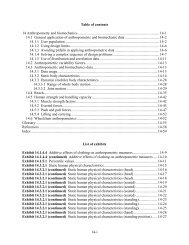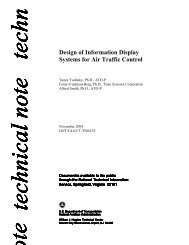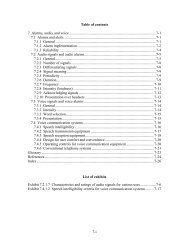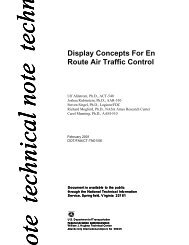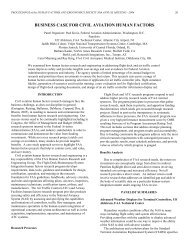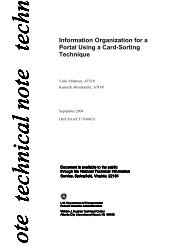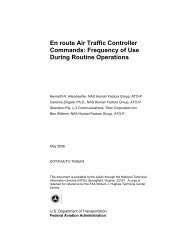Human Factors Criteria for the Design and Acquisition of ... - FAA
Human Factors Criteria for the Design and Acquisition of ... - FAA
Human Factors Criteria for the Design and Acquisition of ... - FAA
Create successful ePaper yourself
Turn your PDF publications into a flip-book with our unique Google optimized e-Paper software.
Keyboards June 20049.10 Keyactivation• 9.10.1 Force to depress keys. The maximum <strong>for</strong>ce neededto depress keys shall measure between 0.25N <strong>and</strong> 1.5N(0.9 <strong>and</strong> 5.3 ounce-<strong>for</strong>ce) with a preferred range between0.5N <strong>and</strong> 0.6N (1.8 <strong>and</strong> 2.2 ounce-<strong>for</strong>ce) <strong>for</strong> normal dataentry tasks. [Source: ANSI, 1988; Armstrong, Foulke, Martin,Gerson & Rempel, 1994; Kinkead & Gonzalez, 1969; NUREG 0700,2002; Radwin & Jeng, 1997; Radwin & Ruffalo, 1999; Rempel,Serina, Klinenberg, Martin, Armstrong, Foulke & Nataraja, 1997;Rose, 1991]Additional in<strong>for</strong>mation. Excessive <strong>for</strong>ce can cause fatigue<strong>and</strong> user discom<strong>for</strong>t <strong>and</strong> can increase carpal tunnelpressure. As <strong>the</strong> <strong>for</strong>ce needed to activate a key increases,finger <strong>for</strong>ce increases. Too high <strong>of</strong> a key <strong>for</strong>ce can lead touser fatigue <strong>and</strong> make it difficult to type. Too low <strong>of</strong> a key<strong>for</strong>ce can lead to inadvertent key activation. [Source:Armstrong et al., 1994; Radwin & Jeng, 1997; Radwin & Ruffalo,1999; Rempel et al., 1997; Rose, 1991]9.10.2 Key <strong>for</strong>ce. Key <strong>for</strong>ce requirements should beuni<strong>for</strong>m across <strong>the</strong> surface <strong>of</strong> <strong>the</strong> key. [Source: Armstrong etal., 1994; Radwin & Jeng, 1997; Radwin & Ruffalo, 1999; Rempel etal., 1997; Rose, 1991]9.10.3 Initial key resistance. Keys should have a highinitial increase in resistance to depress, with resistancedisappearing after closure <strong>and</strong> increasing with overshoot.[Source: Baber, 1997; Brunner & Richardson, 1984]Exhibit 9.10.3.a High initial increase to actuation pointActuation point9-28



